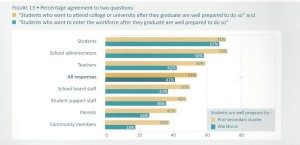High school graduation has long been cherished as a significant milestone in the vast majority of students’ personal lives. News that it is now being reinvented was bound to evoke widespread concern, especially in a time of runaway grade inflation and ‘every-one-gets a pass’ education. That’s why the Ontario Ottawa-Carleton District School Board‘s plan to revamp its high school graduation ceremonies attracted so much public and media attention. A story in the Ottawa Citizen headed “No Pass, No Problem,” reported that everyone would get an achievement certificate whether they passed or not. Little wonder it immediately became the latest flashpoint in the ongoing debate over declining standards in Canada’s schools.
The Ontario public school district, the OCDSB, is proposing to change graduation ceremonies into commencement exercises and striking out “awards” from its policy. It the proposed changes are accepted in April 2024, will soon get recognized at a June “commencement” ceremony without passing or securing a graduation diploma.
The proposed shift replaces “graduation” with “commencement,” but the changes go far beyond a simple doctoring of the language. A graduation marks a stage in a student’s academic career recognizing the successful completion of a program, signified by the achievement of a diploma, and the conferring of a range of academic and non-academic student awards. Changing it to a “commencement” implies that it’s a community celebration, including everyone, which marks “the beginning of a journey” in education rather than a milestone.
The clock is ticking on the changes. Proposed amendments to OCDSB policy P.038.SCO, dating from May 1998, initiated by Associate Director Brett Reynolds and senior staff, were tabled for public feedback until March 29, and will be reviewed on by a board committee on April 4, then presented to the Board of Trustees on April 25 for final approval. That’s clearly not enough time to ensure proper public engagement and accountability, but par- for-the course at the local school board level.
The OCDSB claims that the intent of the change is to make the end-of-year ceremony more inclusive. “At commencement, students of all levels of achievement will be able to cross the stage with their peers,” reads the official statement that accompanied an invitation for members of the public to comment on the proposed change.
The OCDSB rationale downplays the salient difference: “For a variety of reasons, students may not have completed all the requirements for a move on from secondary school. With this change, these students will be able to join their peers and celebrate their achievements.” What students who have not passed the grade are celebrating is a clear as mud. It, in fact, implies that simply “showing up” is now worthy of praise.
Graduation rates have skyrocketed as well as final averages over the past two decades or more. While Ontario high school graduation rates in the early 1990s sat 68 percent, they now soar into the high 80’s and early 90’s. Being an Ontario Scholar used to mean securing an 80 per cent average; today the vast majority of students exceed what was formally a benchmark of academic excellence.
The awarding of high marks is deeply entrenched and that, in many ways, has undermined the value of a high school diploma. In June 2022, for example, some 86.1 per cent of Ottawa-Carleton DSB students graduated in 4 years (Grade 9 to 12) and 90.5 per cent took five years. That’s a little above the provincial average, comparable to Toronto DSB (85.6 %/ 5 years) but lower than York Region DSB (94.2 % / 5years) and York Region Catholic DSB (97.3% / 5 years).
It’s still alarming to examine the impact of the proposed OCDSB changes on the current cohort of graduates. Students who work conscientiously to complete the high school program will have their achievement diminished further by the presence of a smaller group, roughly 14 per cent, who get a free pass to participate in the final ceremony.
The OCDSB policy change did not come out of nowhere. It owes its origins to the OCDSB Strategic Plan for 2023-27 and its undergirding philosophy – a commitment to inclusion, equity and accessibility for all students. While few quibble with embracing inclusive education, the devil is in the details and the extent to which it now overrides the core mission of schools – teaching and learning in the classroom.
Recognizing high student achievement is now being conflated with the “traditional graduation ceremony” and that is seen as antithetical to the overriding goal of “celebrating all levels of achievement” while serving those who have been “underserved” by the school system.
Most inspiring school reforms and policy changes seek to lift children up and to instill what American education psychology professor Carol Dweck calls a “growth mindset.” For students, it amounts to a “commitment to thrive on challenge” where you don’t see failure as a way to describe yourself but as “a springboard for growth and developing your abilities.”
Degrading graduation is completely at odds with fostering a student growth ethic and a commitment to exceed expectations. If the OCDSB policy changes go through and other boards follow suit, it may, in fact, breed complacency and give aid and comfort to what former U. S. President George W, Bush once called “the soft bigotry of low expectations.” It will have arrived when, in the not-to-distant-future, everyone gets a high school participation certificate.
*An earlier version appeared in The Hub Canada, March 14, 2024.
What has happened to erode the value and recognition once accorded to a high school diploma? Does embracing “inclusion” have to be reduced to debasing awards? Why does it amount to lowering or removing academic hurdles, when there are other, more constructive ways of broadening the awards to incorporate a broader range of competencies? What’s the broader impact of removing the incentive to excel, and the reward for excelling, in your studies? Are schools succumbing to the “soft bigotry” of lowered expectations, selling all studernts short?













